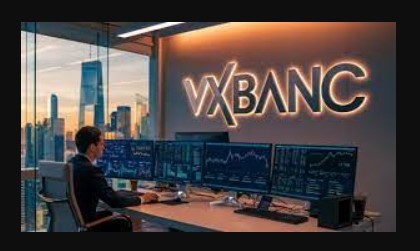VXBanc.com Exposed – Tale Of A Flashy Fintech
Introduction
VXBanc.com scam review exposes hidden red flags—no regulation, low trust scores, regulatory warnings, and suspicious operation. Learn why VXBanc is flagged high risk. The internet is littered with slick fintech platforms promising groundbreaking trading tools, AI-powered analytics, and seamless investors’ experiences. VXBanc.com is one of those names that stands out for its polished branding, bold AI rhetoric, and glowing user reviews. But beneath the modern design and promotional buzz lies a structure that, upon closer inspection, unravels—and shows itself for what it really is: high-risk territory.
This review takes you through the whole story. We’ll look at how VXBanc presents itself, what its marketing says (versus what it doesn’t), the patterns that emerge in its traction and feedback, and why many experienced investors view it as deeply suspicious—even dangerous.
1. Aesthetics and First Impressions: Sleek—but Surface Deep
You land on VXBanc.com, and you’re greeted by a glossy interface: high-resolution hero images of trading screens, bold “AI investment tools,” and headlines about “global reach,” “institutional-grade algorithms,” and “next-level insights for retail users.” It all looks very modern and professional.
That’s deliberate. The visual strategy is to position the platform as a fintech leader—tech-savvy, forward-thinking, and trustworthy by design. It mimics the brand identities of legitimate global players to evoke confidence. When you don’t immediately sense that there’s something off, it’s often too late; our instincts have already accepted the mirror. But for anyone in the industry, that first polish is a clue—smart branding paired with little substance is a classic early warning sign.
2. Reviews That Spark Suspicion
One of the most immediate cues that something is troubling is the review footprint. On sites like Trustpilot, VXBanc.com shows a near-perfect score: 4.3 or more out of 5, with dozens of five-star reviews exclusively. The comments are glowing—“Fast deposits,” “Excellent AI tools,” “Responsive support,” “Dashboard so intuitive.”
That might sound encouraging, especially to newcomers. But in established industry wisdom, when a brand with virtually no operational history (domain was registered late last year) has a surge of near-perfect reviews, red flags go up. Genuine platforms typically see a wider range of feedback: praise, criticism, suggestions, complaints, and edge-case experiences. A sudden influx of highly uniform praise—often worded similarly—is more consistent with reputation-seeding campaigns than organic user sentiment.
3. Domain Age & Ownership Opacity
Domain registration date matters. VXBanc.com is very new—just a few months old profiles on web-registry records, a short footprint in the digital world. Most credible financial service brands have history, and their domain lifecycles reflect that.
Adding to the concern: the domain’s ownership is hidden behind privacy protection. Many legitimate companies use privacy shielding for email addresses or personal contact info, but full WHOIS masking of ownership—without clear public corporate identity—is a major transparency red flag. When you cannot trace who’s behind the brand, accountability and verifiability evaporate.
4. AI Marketing vs. Actual Authority
VXBanc positions itself at the cutting edge of finance with phrases like “AI-driven financial tools,” “institutional algorithmic insights,” and “transforming the retail investment landscape.” It’s alluring language, tapping both on fintech hype and the fear of missing out (FOMO).
But when claims lean heavily on marketing lingo—without pointing to real regulatory credentials, third-party reviews, or verifiable institutional partnerships—the substance doesn’t back the story. In true fintech innovation, you’ll find certifications, public audits, regulatory identifiers, legal disclosures, and named leadership teams—all missing here.
The more hype, the more you have to ask: where’s the proof?
5. Regulatory Blind Spots
One of the most serious reasons for concern is regulatory non-existence. VXBanc.com is not registered with any recognized securities or financial regulatory authority. When evaluated by official investor-protection listings, it’s flagged as unregistered and potentially operating illegally in multiple jurisdictions.
Normally, brokers proudly display their license numbers, regulatory bodies, or audit information for prospective clients to verify. The silence here is deafening. When you ask the platform (through support) for licensing info, they may reply vaguely—“We comply with global standards”—without giving specifics. That’s a classic evasion strategy.
6. Algorithmic & Technical Risk Signals
VXBanc’s marketing platform highlights “cutting-edge algorithms” and “AI analysis.” That suggests trading edges or proprietary advantage. The concern: when evaluation platforms run technical checks on the domain or associated IP networks—signature analysis, malware or phishing potential, suspicious registrars—they deliver low trust scores across the board.
The registered domain appears connected to other flagged sites; the technical evaluation suggests phishing proximity, low legitimacy, and high spam risk. Combine that with zero institutional references—not a single proof of real financial partnerships—and it tilts the scale firmly into the “high-risk” bucket.
7. PR Fireworks, Real-World Disconnection
VXBanc was introduced in a series of press releases proclaiming expansion into retail markets, institutional-level AI, and global market disruption. On paper, it looked like the next fintech darling.
Reality check: there’s no independent confirmation of any enterprise clients, no traceable corporate registry in financial capitals like London or Singapore—and no trace of actual institutional users. Press releases without verifiable substance (such as named partners, media confirmations, or physical offices) are often branding exercises, not evidence of traction.
8. The Allure of “High-Performance”—With Hidden Strings
Let’s say you sign up and deposit funds. The platform’s “AI signals” deliver immediate “profits,” your dashboard lights up in green—profitability appears real. That’s when the trust-building continues.
But these are often modeled simulations—”winning” trades orchestrated to fuel more deposits. Soon you’re introduced to VIP packages: higher tiers, exclusive signals, private webinars—each requiring larger amounts. It’s classic funnel design: early wins cue emotional trust; then bigger asks follow.
Once you open a withdrawal request, that’s when friction begins. Suddenly “fees,” “verification requirements,” “unforeseen compliance delays,” and “AI validation audits” show up as reasons to hold your funds. It’s textbook: stall the outflow, keep the inflow hot.
9. No Real Exit Path—Emotional Leverage
As weeks pass, you feel trapped. Your funds are inaccessible and support becomes vague. The earlier “account manager”—if real—is now less available. You’re encouraged to deposit more to unlock your funds or to “stabilize your account.”
This plays on fear and optimism—fear of loss, and optimism that one more deposit or signal will open the gates. Without regulation and clear recourse, you’re dependent on goodwill. And that’s perilous territory: when something looks too controlled, your capital isn’t safe.
10. Summary Table: Shine vs. Shadow
| Glamorous Facade | Underlying Risk & Evidence |
|---|---|
| Glossy, modern design | Shallow domain history and ownership opacity |
| High Trustpilot ratings and reviews | Overly positive tone; likely seeded with few authentic critiques |
| “AI-driven” tools & fintech branding | No demonstrable tech reports, audits, or licensed partnerships |
| Institutional and global marketing | No traceable infrastructure, offices, or verified client relationships |
| “Fast profits” and VIP packages | Clear incentive funnel that amplifies deposits while deferring withdrawals |
| No licensing or regulatory information | Unregistered in multiple jurisdictions; flagged by investor-protection bodies |
| Press release proliferation | No independent media coverage or verifiable partnerships |
| Dashboard wins as trust levers | Likely simulated success stories; no real trading transparency |
| Withdrawal friction at the exit | Strategic stalling and demand for extra meet-conditions or fees |
Final Verdict
VXBanc.com is the textbook example of a platform that blends high-end presentation with dangerously hollow substance. It leverages AI branding, exceptional-looking dashboards, curated reviews, and VIP-level exclusivity—while carefully avoiding regulatory exposure, transparency, and accountability.
If you’re evaluating new fintech or trading tools, run the checklist: domain age, ownership clarity, license verification, independent reviews, realistic feedback distribution, audited tech and pricing models. VXBanc falls short on nearly every metric.
In financial services, marketing can be deceptive, but risk is real. And with VXBanc.com, the evidence strongly suggests that whatever you deposit is more likely to be held hostage than harvested—if you ever get it back at all.
Proceed with extreme skepticism. When legitimacy is absent, presentation alone isn’t worth the gamble.
Report VXBanc.com scam and Recover Your Funds
If you have lost money to VXBanc.com, it’s important to take action immediately. Report the scam to Jayen-consulting.com, a trusted platform that assists victims in recovering their stolen funds. The sooner you act, the better your chances of reclaiming your money and holding these fraudsters accountable.
Scam brokers like VXBanc.com continue to target unsuspecting investors. Stay informed, avoid unregulated platforms, and report scams to protect yourself and others from financial fraud.
Stay smart. Stay safe.






